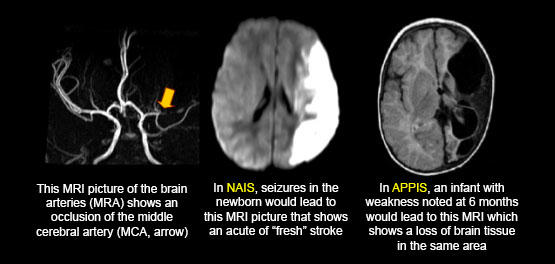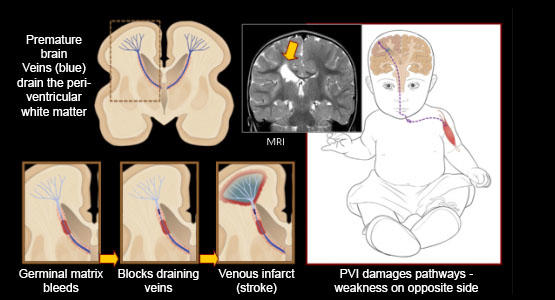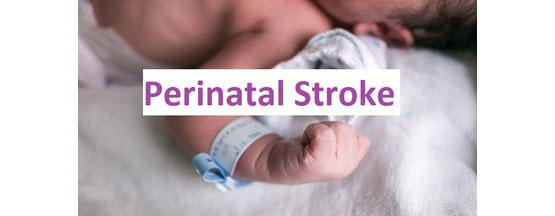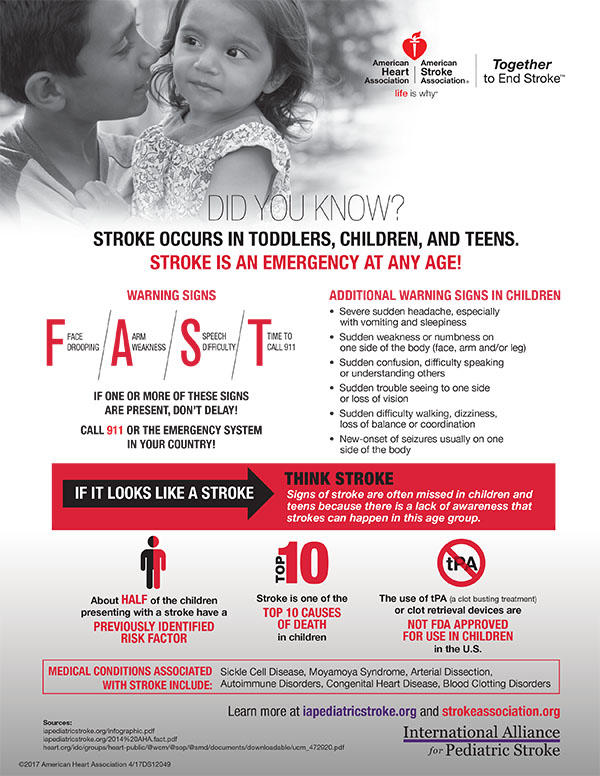About Stroke
The following information is designed to provide a general education about perinatal stroke. The information is based on current evidence from the medical literature and the collective experience of the Calgary Pediatric Stroke Program (CPSP). Information is kept current as best possible.
However, our field continues to have more questions than answers. Therefore, differences in terminology and information may differ from other resources. Readers are encouraged to discuss inconsistencies and questions with our team in the clinic.
Also see our Frequently Asked Questions page.
Topics:
What is pediatric stroke?
Stroke refers to an area of brain damage caused by a problem in brain blood vessels. There are many types of cerebrovascular (brain blood vessel) diseases that cause stroke in newborns and children.
Stroke does NOT refer to other types of brain injury in children including:
- Lack of blood supply to the entire brain (hypoxic-ischemic encephalopathy)
- Lack of glucose (sugar) to the brain (hypoglycemia)
- Trauma to the brain
- Other brain diseases (e.g. infections, genetic diseases, etc)
How are pediatric strokes classified?
Three main factors determine how stroke is classified in children:
1. TYPE OF STROKE
- Ischemic stroke is brain damage resulting from the blockage of a blood vessel, typically by a blood clot.
- Hemorrhagic stroke is bleeding into the brain from the rupture of a blood vessel.
2. BLOOD VESSEL INVOLVED
- Arteries are the thick tubes that carry blood from the heart to the brain. Therefore, blockage of an artery in the brain is called an Arterial Ischemic Stroke (AIS).
- Veins are the thin tubes that carry blood away from the brain, back to the heart. The venous sinuses are large vein spaces within and around the brain that drain blood. Therefore, blockage of a vein or sinus in the brain is called a Cerebral Sinovenous Thrombosis (CSVT).
3. AGE OF CHILD
Stroke can occur at any time in a child’s life including:
- Fetal = time before birth. Also called “prenatal” or “in utero”.
- Neonatal = time from birth to 1 month of age. Also called newborn.
- Childhood = >1 month to 18 years old
Perinatal stroke collectively refers to strokes at or before birth (fetal and neonatal). Classification of perinatal strokes is more complicated.
Premature babies can have the stroke types mentioned here. However, many premature brain injuries are not stroke.
Different types of childhood strokes
There are three main types of stroke in childhood (>1 month - 18 years)
- Childhood Arterial Ischemic Stroke (AIS) - more information
- Childhood Cerebral Sinovenous Thrombosis (CSVT) - more information
- Childhood Hemorrhagic Stroke (HS)
What is perinatal stroke?
Stroke typically refers to the blockage (ischemic stroke) or breakage (hemorrhagic stroke) of a blood vessel (artery or vein) in the brain.
Perinatal refers to the timeframe that extends all the way from the middle of pregnancy (fetal life) through birth and the first month of life.
Perinatal strokes are focal diseases of brain blood vessels that lead to injury in the brain during the fetal or newborn period. Perinatal stroke is not just one disease as several specific types are now recognized.
Different types of perinatal stroke
Perinatal strokes can be accurately classified by considering the following factors:
1. Type: Ischemic or hemorrhagic
2. Blood vessel affected: Artery or vein
3. Timing of injury: Before birth (fetal) or around time of birth
4. Timing of symptoms: At birth or later in infancy
The most common forms of perinatal stroke are Neonatal Arterial Ischemic Stroke (NAIS) and Presumed Perinatal Ischemic Stroke (PPIS).

Neonatal Arterial Ischemic Stroke (NAIS)
Neonatal Arterial Ischemic Stroke (NAIS) results from an acute blockage (ischemia) of a brain artery recognized around birth. Seizures are usually noticed in the newborn. This leads to an MRI scan that confirms the recent stroke. Imaging usually suggests the stroke has occurred sometime within the preceding days.
NAIS is the most studied variety of perinatal stroke. Additional information about NAIS can be found here.
Presumed Perinatal Ischemic Stroke (PPIS)
Many perinatal strokes are not recognized at birth. This is usually because the baby shows no physical signs of their stroke, even when a large or multiple strokes have occurred.
Instead, parents begin to notice the consequences of the stroke later in the first year of life. This is when the child begins to use the areas of the brain that have been injured by the stroke. The most typical sign is an asymmetry in body movements where parents notice that one side of the body is moving better than the other. Children should not show a clear preference to be left or right handed before their first birthday, often much later than this. Such weakness on one side in a young infant has often been called congenital hemiplegia or hemiplegic cerebral palsy (CP). The majority of these are due to a perinatal stroke.
Other neurological concerns may also arise in the first year such as seizures or other developmental difficulties.
In all these cases, a picture of the brain (preferably MRI) should be done. In many cases, the MRI will show damage consistent with an old stroke.
Since this diagnosis is made retrospectively (after the fact), we use the term: Presumed Perinatal Ischemic Stroke (PPIS).
Arterial Presumed Perinatal Ischemic Stroke (APPIS)
Arterial Presumed Perinatal Ischemic Stroke (APPIS) is very similar to neonatal arterial ischemic stroke (NAIS). Both are due to an occlusion of a brain artery, usually by a blood clot. The only difference between the two may be the timing that symptoms are realized – at birth or later in infancy. Examples of both NAIS and APPIS are shown in the figure on the right.
In APPIS, a child’s symptoms are recognized later in infancy. This is usually when parents or physician notice one side does not move as well (hemiparesis). APPIS can also present with seizures or other developmental concerns. This leads to an MRI that scan that shows an old stroke consistent with an arterial occlusion.
Most APPIS are blockages of the middle cerebral artery or its branches. As a result, the damage that occurs usually affects both the outer surface of the brain (cortex) as well as deeper (subcortical) areas of the brain. The timing cannot be determined exactly but many APPIS may be the same as NAIS, the only difference being the time of when symptoms were seen.

Periventricular Venous Infarction (PVI)
This presumed perinatal ischemic stroke is different than APPIS or NAIS in several ways.
PVI are fetal strokes because they occur well before birth while the baby is still in the womb. The details of what happens with PVI are explained here in more detail and shown in the figure on the right.
The structure of the premature brain (less than 34 weeks gestation) is different than the term brain. A collection of blood vessels called the germinal matrix lies deep in the brain where they nourish growing brain cells. The germinal matrix is located just below the ventricles – normal, fluid filled spaces in the brain.

Bleeding of the germinal matrix is the primary problem in PVI. Why such bleeding occurs is not well understood. The blood can spill into the neighboring ventricle (so-called intraventricular hemorrhage). Germinal matrix bleeding can also lead to a blockage of veins that drain blood from a specific brain area. This blockage of blood flow in the vein may also lead to a blood clot forming and further blocking blood flow.
These medullary or terminal veins drain blood from the area just beside the ventricle or periventricular region. In PVI, the germinal matrix hemorrhage leads to such an impairment of blood drainage from the periventircular white matter that it becomes injured or infarcted (i.e. a stroke).
The periventricular area contains white matter – the insulated “wires” that carry information in the brain. PVI often occurs in an area where the white matter carrying information from the brain to move the opposite side of the body are present. These are called the corticospinal tracts. The result of many PVI is damage to the corticospinal tracts with subsequent weakness on the opposite side of the body (congenital hemiplegia or hemiplegic cerebral palsy).
PVI is similar to APPIS in that the weakness is usually not appreciated at birth but only later in infancy.
PVI is different from APPIS in the timing of the stroke (before birth) and the areas of the brain affected. PVI damage is only in the periventricular, subcortical region and does not involve the cortex like APPIS. This may be one reason why the outcomes in PVI and APPIS are different.
Cerebral Palsy (CP)
Cerebral Palsy (CP) refers to a motor (physical movement) difficulty that results from an abnormality or injury to the brain before or around the time of birth. Therefore, for stroke, the term CP only applies to perinatal stroke. The term CP is not correct for childhood stroke though many children share similar neurological problems (i.e. weakness on one side).
The term CP is just a description of symptoms, not a disease itself. In other words, an underlying disease causes CP, stroke being just one example.
There are MANY different kinds of cerebral palsy.
- Hemiparesis is weakness on one side of the body.
- Hemiplegia is complete weakness on one side of the body.
- Hemiplegic CP refers to CP that only affects one side of the body.
Perinatal stroke is by far the most common cause of hemiplegic/hemiparetic CP. As most hemiplegic CP is evident early in life, the term congenital hemiplegia is also used. Other common types of CP that involve both sides of the body (diplegia, quadriplegia, hyperkinetic/choreoathetoid) are usually due to diseases other than perinatal stroke.
There is a very wide range in the degree of CP, from mild to severe. As CP reflects an injury to the brain, some affected children have additional neurological disabilities including challenges with language, behaviour, learning and intellectual function.
For more information on cerebral palsy, please see this link: Cerebral Palsy
Seizures
A seizure is a sudden discharge of extra "electrical" activity in the brain. Seizures often originate in an area of the brain that has been injured. Seizures may occur right at the time of the injury, many years later, or any time between. This is true in all types of perinatal and childhood stroke.
Epilepsy
Any person who experiences more than one spontaneous seizure has epilepsy. There is a wide range in the types, severity, and causes of epilepsy. Strokes injure the brain and may lead to epilepsy.
Seizures and epilepsy do not cause strokes. Overall, about 25-30% of children with the most common types of stroke will have epilepsy.
Additional information on seizures and epilepsy is available in the clinic and here:



